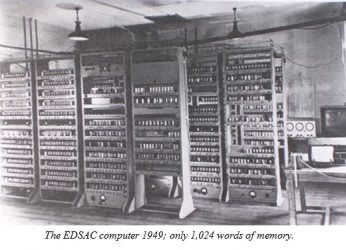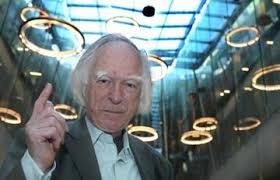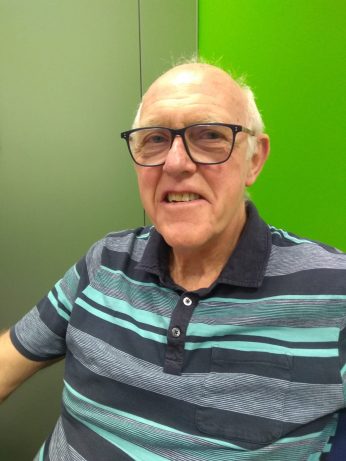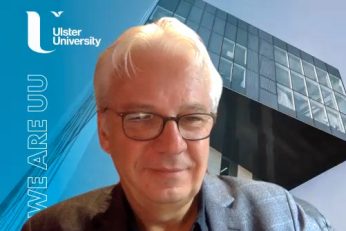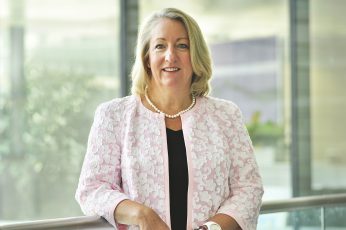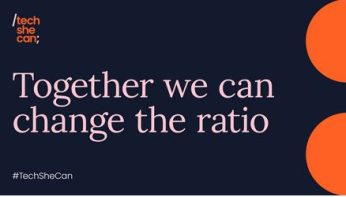As Information Technology found increasing application in the workplace it was seen as both an opportunity and a threat. While it offered to to make tasks easier and reduce costs it was seen as a threat to the jobs of people.
In 1963, future Prime Minister Harold Wilson gave aspeechin which he forecast that the future of the UK would be forged in the ‘white heat’ of a technical revolution citing the role of computers and automation as key to the industrial future. He was saying that the UK had no choice but to use new technology in order to succeed in trade and industry was asking people to understand that it was in everyone’s best interests.
Did you know?
Harold Wilson was influenced in his views on technology by Norman Sanders, whom he met when visiting the USA before becoming Prime Minister – see 1948 above – you can read their letters here.
Sir Peter Gerschon, Archives of IT
Graduating from Cambridge with a first in mathematics was a perfect start to an accelerated graduate career which bought Peter Gershon to the board of ICL. This was a springboard for Peter to move to the board of GEC and ultimately become the first Chief Executive of Government Commerce where he worked to identify where the government could save £6bn, which he did in 2003 producing the Gershon Review in 2006.
ICL, Archives of IT
ICL (International Computers Limited) existed as a commercial entity from 1968 to 2002.
Not everyone agreed but Wilson’s government was later responsible for the creation of the flagship computer company ICL (International Computers Ltd) in order to help the UK compete against foreign computer manufacturers.
Milestone Moment
The development of minicomputers in the 1960s and microprocessors in the 1970s enabled a huge growth in the IT services industry, not just on the factory floor but also in the back office. New systems, such as electronic payroll, changed the working life of people in the UK.
John Leighfield, Archives of IT
John Leighfield CBE was a pioneering user of IT, applying the technology offered by vendors to the benefit of users, particularly in manufacturing.
He started in IT with Ford in Dagenham, in what would now be called Systems Analysis. He joined Plessey in 1965 and was on the board of Plessey as the head of IT. John moved to British Leyland in 1972, working in BL Systems (later renamed as ISTEL). ISTEL was privatised and John and others succeeded in a management buyout.
Geoff Henderson, Archives of IT
Geoff Henderson was an IBM’er for 27 years, between 1973 and 2000, joining as a systems engineer and retiring as Region Director Finance Sector, EMEA. Before joining IBM Geoff worked for the Steel company of Wales from 1960 to 1973, where he headed the team that developed the world’s first real-time shop floor reporting system in the steel industry.
Did you know?
By 1970 there were approximately 2,000 computers in use in the UK, compared with just 4 in 1951.
There are now over 200 million computers in the UK.
1978: From a small Acorn to the BBC Micro. The birth of home computing
During the early 1980s, the BBC started what became known as the BBC Computer Literacy Project. The project was initiated partly in response to an ITV documentary series The Mighty Micro, in which Christopher Evans of the UK’s National Physical Laboratory predicted the coming microcomputer revolution and its effect on the economy, industry, and lifestyle of the United Kingdom.
Christopher Curry, Archives of IT
Chris Curry was a central figure in the Cambridge phenomena which was Sinclair, Acorn and ARM. He started on the production line at PYE, worked for the Royal Radar Establishment and eventually arrived at Sinclair Radionics in 1966. He then helped set up Acorn Computers with its first product the Atom. Acorn was approached by the BBC and devised the BBC Micro, launched in 1980 it sold 3 million.
Acorn Computers was founded in 1978 and was an innovative company that made home computing a reality. Acorn Computers developed the Proton and Atom computers that were both based upon the popular 8-bit microprocessor, the MOS Technology 6502.
In 1980, Acorn Computers developed the BBC Micro, based on the Proton prototype, as part of the BBC Computer Literacy Project. The BBC Micro was a feature rich computing platform with a wide range of input/output devices, and included a revolutionary idea for the time – the ability to network multiple computers together to share data and access to peripheral devices such as printers and mass storage hard disks.
Dr Herman Hauser, Archives of IT
Hermann Hauser co-founded Acorn Computers and guided it through its growth and teh success of teh BBC Micro. He founded the Olivetti Research la in Cambridge but left in 1988 to found the Active Book Company and in 1990 he helped spin out ARM from Acorn. He continues to look for new ventures and in 1997 co-founded the venture capital IT partnership Amadeus based in Cambridge.
The BBC Computer Literacy Project, Archives of IT
The BBC Computer Literacy Project was a national educational programme initiated and led by the BBC.
Sir Clive Sinclair, Archives of IT
Sir Clive Sinclair was a well-known British entrepreneur and inventor of the world’s first “slimline” electronic pocket calculator in 1972 (Sinclair Executive) and the ZX80, ZX81, and ZX Spectrum computers in the late 1970s and early 1980s, amongst other things.
Sinclair Research were Acorn’s biggest rival in the UK computing world and the Sinclair ZX Spectrum was released in 1982.
Clive Sinclair is probably most well-known for his electric velomobile, the Sinclair C5. But in 1972 he produced the Sinclair Executive, a slimline pocket calculator. It was the first mass produced calculator and on its launch cost £79, equivalent to £1000 today – twice the price of the average weekly salary in 1972!
Did you know?
Demand exceeded all expectations and one million BBC Micros were sold within three years.
Many of the leaders of the UK IT industry interviewed by AIT learnt to program on the BBC Micro as their first computer. Search BBC Micro on our home page.
By the early 1980’s the idea of using computers in the home for hobbies and business was well established.
1982: Information Technology Year

Those words were published with a commemorative stamp set to mark the occasion of Information Technology Year and the accompanying leaflet went on to to say, At a time when most industries are static or declining, information technology presents great economic and job opportunities for Britain. The IT industry is expected to expand dramatically throughout the 1980s …
1982 was Information Technology Year (IT82), a campaign to increase public awareness of how IT could be used by everyone.
The Department of Trade and Industry and commercial businesses jointly invested £3.75 million to fund exhibitions and demonstrations of IT across the UK. There were also training programmes and summer camps for young people.
By the end of the year, there was a BBC Micro computer in every school in the UK.
Lord Kenneth Baker is a politician who has had most influence on the UK IT industry. He was appointed the first Minister of IT in 1981 and spent four years promoting IT and the IT industry. He salvaged International Computers Limited (ICL), the state-owned computer company, twice. He launched IT82 a successful awareness campaign which coincided with the second year of the BBC Micro and its accompanying BBC TV programmes.
Ken Barnes, Archives of IT
Ken Barnes co-founded one of the first software companies in the UK: Systems Programming Ltd (SPL) in 1963. It started with three programmers and within two years had 150 people. It eventually became the largest software company in Europe. In the early 1980s he was approached by the new Minister for IT to run a year-long campaign promoting the uses of IT in the UK: IT82
1985: London Calling … The first ‘mobile’ phones
The privatisation of BT created new opportunities for innovators in the telecommunications market.
On 1st January 1985 Ernie Wise made the first ever (civilian) telephone phone call from a ‘brick sized’ cellular phone.
Later that year, the RISC microprocessor was developed that could perform complex functions without the need for large batteries. Cellular phones could now be miniaturised to pocket size, sparking a revolution in personal communications. This technology is now used in one billion phones around the world.
Did you know?
That the telephone service in the UK used to be provided, along with delivering letters, by the Post Office?
That changed in 1981, when British Telecom (BT) was created. In 1984 BT became a private company and shares were sold to the public.
John Carrington, Archives of IT
John Carringtonwas the founding Managing Director of Cellnet, BT’s mobile telecommunications arm, in 1983. He helped European partners develop the Global System for Mobile Communications (GSM), which became the de-facto standard for the world.
Dr Steve Furber CBE, Archives of IT
Steve Furber was working at Acorn computers having helped develop the BBC Micro and was searching for the follow-on product. He found that the microprocessors then on the market had a deep design flaw: the were too complex. Acorn decided to design its own microprocessor using a novel approach. Furber led the small team. They called it the Acorn Risc Machine (ARM), later changed to the Advanced Risc Machine and it is now found in over a billion mobile devices worldwide.
Milestone Moment
The City of London has a long history of professions promoting standards, supporting education and training and undertaking charitable work through livery companies. As a modern profession the IT industry continued this tradition by establishing the 100th livery company, The Worshipful Company of Technologists.
In 1986, the Worshipful Company of Information Technologists (WCIT) was made a City Company without grant of livery. Six years later, they were awarded full livery company status.
1989: The World Wide Web
In 1989, in the UK, mobile phones and personal computers were becoming common. Businesses used networks to connect computers in different locations and to share data and industry experts were predicting a revolution based on the joining up or convergence of computing and communications.
But, for most of us, phones were for talking to other people and personal computers were for word processing, spreadsheets and slide shows. Most people could not imagine how connecting a computer to a telephone line was going to change our lives.
While working at CERN in Geneva in 1989, Tim Berners-Lee developed a global hypertext system that would allow information to be shared on the internet via a web browser and server.
It was the start of the World Wide Web.
Did you know?
On 30th April 1993, the source code of the World Wide Web was made available on a royalty-free basis, making it free software.
Eva Pascoe, Archives of IT
Internet cafes made IT and the www accessible to all. Eva Pascoe was one of the founders of the UK’s first internet café, Cyberia Café, in Fitzrovia, London in 1994. Cyberia quickly grew in popularity and expanded within the premises to include Subcyberia for gamers, and Transcyberia for co-working.
In the mid 1990s Internet entrepreneurs saw new opportunities to build tech businesses. 1995 marked the start of the dotcom boom.
Milestone Moment
The Internet provides communications for us to access the world wide web and the public did not have access to that until commercial companies provided technology to “dial up” via a home telephone line, using a modem. Pipex was established in 1990 and began providing dial-up internet access in March 1992, the UK’s first commercial Internet provider.
The www access via the Internet was the start of a digital revolution that was to impact almost every aspect of business and leisure.
1995: Click, Collect, Deliver. A shopping revolution
The mid 1990s saw the birth of online shopping. Both Amazon and Ebay were launched and, as more people had computers in their home, there was a growing market for online purchases.
In 1998 Martha Lane Fox and Brent Hoberman founded Lastminute.com and changed the way we booked holidays and travel forever.
Baroness Martha Lane Fox, Archives of IT
Martha Lane Fox led the team which built the commercially successful Internet application lastminute.com. She now runs dotevedryone.org a think tank and campaigning organisation to develop a responsible digital economy and is Chancellor of the Open University.
Edwina Dunn OBE, Archives of IT
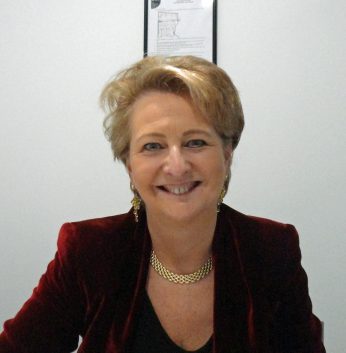
Edwina Dunn OBE has spent her 40 years in the IT industry analysing great globs of data and turning it into useful business information to guide businesses. We call that today the analysis of big data. She started at the US CACI company which used census data to help customers such as banks and building societies. She left with her husband after nine years and they formed their own consultancy focusing on analysing customer data. Their big breakthrough was launching the Clubcard customer service for Tesco which catapulted Tesco to the front rank of UK grocery marketing.
Did you know?
In 2000:
1 million people were employed in the IT industry in the UK.
Online spending was 1% of total retail.
In 2020:
2.5 million people were employed in the IT industry in the UK.
Online spending was 19% of total retail.
1998: Artificial Intelligence. Medical technological research reaches new boundaries
Professor Kevin Warwick, Archives of IT
In 1998, Kevin Warwick, a professor of Cybernetics, was the first person to have an electronic microchip implanted into his arm. The microchip tracked and monitored his movement, but it also allowed him to control devices in his office.
In 2002 his nervous system was connected via the internet to his wife’s, and he was able to feel the impulses caused by her physical movement.
This level of technology is still heavily based in research but 20 years later offers the prospect of overcoming neurological disease by communicating with the brain through artificial intelligence.
2003: Congestion Charge. Technology and transport
The London Congestion Charge was the largest technology-based traffic management scheme in the world.
It was a controversial scheme when it was introduced but traffic congestion in central London was reduced by 30% in its first year of operation.
Sir Rod Aldridge OBE, Archives of IT
Sir Rod Aldridge OBE worked in local government on the south coast of England before studying in the evenings to earn his professional qualification as an accountant. He then worked for the professional body of accountants in the public sector and worked on developing guidelines for the implementation of IT systems in local authorities. From this sprang the idea of offering IT outsourcing services to the public sector. Aldridge spun the operation out of the professional body and led the development of what became Capita from one employee to 74,000. On retirement from Capita his philanthropic work includes Ada, the National College for Digital Skills to help develop the core of skilled coders in the UK.
Did you know?
Transport for London introduced the Oyster Card in 2003. It was the first large-scale use of contactless smartcard technology in the UK.
Since it’s launch, over 86 million Oyster cards have been issued.
Milestone Moment
The Apple iPhone was launched in 2007 and revolutionised telecommunications.
2014: Alexa. Controlling technology with your voice
Amazon released Alexa and enabled us to access information and control household devices via speech technology. In 2014 Alexa began with 130 skills. It now has over 100,000.
Over 100 million Alexa devices have been sold and many other companies have produced their own versions of digital assistants controlled through voice recognition technology.
Dr Catherine Breslin, Archives of IT
Dr Catherine Breslin is a machine learning scientist specialising in speech and language technology. She has a distinguished academic background with a degree from Oxford and post-graduate qualifications from Cambridge. Her career has been about the application of speech and language research to real-world problems. She has worked for Toshiba and then Amazon, where she played a major role in developing Alexa onto other platforms.
2018: Unicorns and Video Games. The new UK Tech industries
Unicorns are fast-growing companies valued at $1bn or more. London is Europe’s number one tech hub for unicorn companies.
The UK also has the largest video games sector in Europe with a reputation for attracting and developing world-class talent.
Sarah Bond, Archives of IT
Sarah Bond leads Microsoft’s gaming business development team. She and her team are responsible for cultivating and managing Microsoft’s gaming partnerships.
Sarah says one of her proudest achievements at Microsoft has been presenting at the company’s E3 game conference; watched by 100 million people every year.
Dr Jo Twist, Archives of IT
Dr Jo Twisthas been CEO of Ukie since 2012. Before this she was Channel 4’s Commissioning Editor for Education, where she commissioned Digital Emmy-winning Battlefront II, free to play browser and iOS games, (Sweatshop, Nomnation and International Racing Squirrels) and social media projects. She is a London Tech Ambassador, a VP of Special Effect, and on various boards and advisory groups, including the Bafta Games Committee.
Did you know?
There are currently over 36 million video game users in the UK.
2020: IT in a Covid World
Did you know?
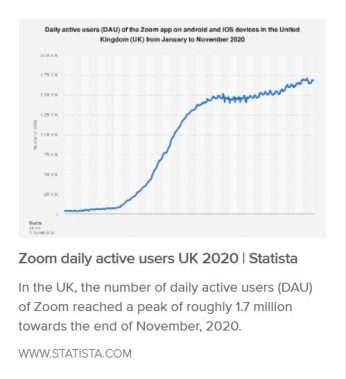
Use of the Zoom video meetings app soared as Lockdown prohibited social contact and everyone who could worked from home.
Life in the normally bustling City of London was transformed by Lockdown. Professor Michael Mainelli was an Alderman and Sherriff of the City at the time gives his view of a bright future.
